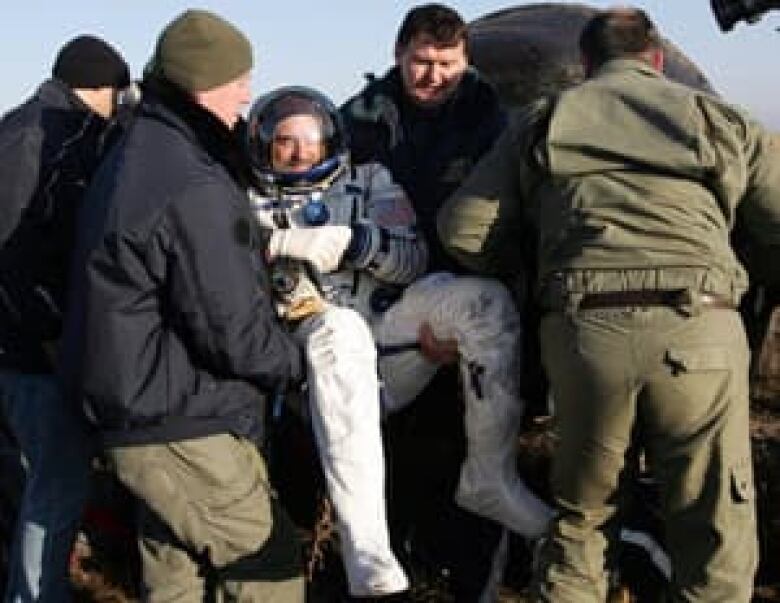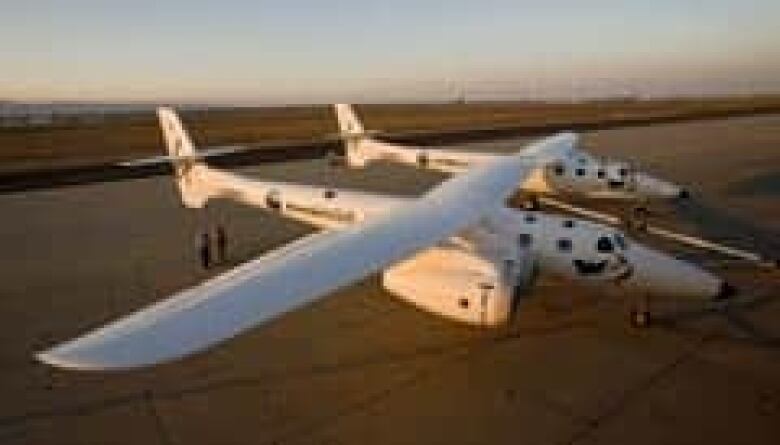Civilians in space: FAQ
On March 26, 2009, billionaire software engineer Charles Simonyi made a return trip to the International Space Station, becoming the first "space tourist" invited back to the orbiting outpost. At the time, it was also believed he would be the last civilian in space, as Russian officials indicated seats would be at a premium once the United States retired its fleet of shuttles in 2010.

Lalibert will be the first Canadian space tourist and just the seventh civilian to fly alongside astronauts and cosmonauts on the Russian Soyuz spaceships.
The 49-year old will be accompanied by a Russian cosmonaut and an American astronaut and is scheduled to spend 12 days on the International Space Station. While there, he'll get to meet Robert Thirsk, the Canadian astronaut who just began a six-month stay on the station.
For a previous generation of millionaires, the literal summit of achievement was climbing Mount Everest. But the mountain first conquered by Sir Edmund Hillary and Tenzing Norgay in 1953 is now littered with tourists and is no longer an exclusive club. Space exploration, on the other hand, remains both prohibitively costly and dangerous enough that only a few civilians have been given the chance to make the attempt.
How does one become a space tourist?
It helps to have money. In April 2001, Dennis Tito became famous as the world's first "space tourist," paying his own way on a Russian Soyuz spacecraft to spend a week on the International Space Station.
Tito underwent extensive cosmonaut training and medical tests in Russia to ensure his fitness before going to the space station. He agreed to replace any equipment he broke and to stay mainly in the Russian part of the station, though NASA allowed him an escorted visit into the American sections. He reportedly paid $20 million US for the privilege.

However, the world's five biggest space agencies have now established health and training standards for both astronauts and visitors to the space station.
Tito was followed a year later by South African internet millionaire Mark Shuttleworth. Greg Olsen, an American entrepreneur and scientist, became the third space tourist in October 2005.
The fourth space tourist, tech businesswoman Anousheh Ansari, went up on a Soyuz spacecraft Sept. 18, 2006. Ansari set many firsts with her flight: She became the first female space tourist, the first Muslim woman in space and the first Iranian in space.
While it is known that Tito, Shuttleworth and Olsen all paid about $20 million US to go into space, Ansari's agreement with the Russian space agency forbids her from talking about how much she paid for her ticket.
Simonyi became the fifth space tourist in 2007 and was followed by American computer game designer Richard Garriott, the son of U.S. astronaut Owen Garriott, who flew on the U.S. space station Skylab in 1973. Garriott flew to the station and back in October 2008.
Simonyi paid $35 million US for his second trip in March. It's not yet known what Lalibert paid for his opportunity.
Is there any other way a civilian can get to the space station?
Space tourists weren't the first non-astronauts to get a seat into space. The Russian space agency had previously accepted cash to take Japanese journalist Toyohiro Akiyama and British chemist Helen Sharman up to Mir, the Russian space station.
Because they didn't pay their own way, they're considered business travellers, rather than tourists.
They also weren't the first civilians to train for a space mission. Christa McAuliffe, a teacher who was killed in 1986 with her six crewmates when the space shuttle Challenger exploded shortly after launch, had been part of a program that allowed civilians to go into space without training as full-fledged astronauts.
But NASA cancelled the program after the Challenger disaster.
Barbara Morgan, who has also been a teacher and McAuliffe's backup on the Challenger mission, did go into space in August 2007, but she had to do it the old-fashioned way by joining the astronaut corps in 1998.
Is space tourism viable as a business?
NASA has studied the possibility of commercial space flight. One such study, released in 1998, suggested that space "cruises" could be a viable industry worth tens of billions of dollars a year if the cost of a ticket could be brought down to $100,000 US. But this same study showed that NASA would have to charge $10 million per ticket if they crammed 50 seats into a space shuttle and that's just to break even.

The International Space Station, for example, orbits at a distance of more than 350 km above the Earth.
Billionaire Richard Branson's Virgin Atlantic has a division with the ambitious name of Virgin Galactic that plans to take six passengers on a suborbital flight in its SpaceShipTwo by 2011 from a launch site in the United States and 2012 from a flight facility in Sweden.
The company bought the rights to develop a fleet of spaceships capable of suborbital flight based on the design of SpaceShipOne, the first commercially built ship to make two flights at a height of 100 km above the Earth.
On March 17, 2009, Virgin Galactic said it had signed up five Nordic travel agencies that will be authorized to sell tickets for both the U.S. and Swedish launches. As of March, nearly 300 tickets at a hefty price of $200,000 US have already been sold, a company spokesperson said.
Another spaceport could be coming to west Texas. Blue Origin, a company founded in 2000 by Amazon.com executive Jeff Bezos, is planning a launch site for sub-orbital flights in Culberson Co., Texas. But so far Blue Origin has only test launched a vertical takeoff and landing vehicle designed to take three astronauts on sub-orbital trips into space.
When did private companies enter the space race?
Private space exploration really took off with the launch of the Ansari X Prize. Named after sponsors Amir and Anousheh Ansari (the latter being the world's fourth space tourist) the Ansari X Prize was a competition to build and fly a reusable space vehicle entirely with private money. The winner had to safely fly a ship capable of carrying three people to the edge of space (100 km up) and back twice in a two-week period. There were about two dozen teams from seven countries competing for the $10 million US prize.
The prize was inspired by the Orteig Prize, first offered in 1919. In 1927, its $25,000 US purse lured Charles Lindbergh to make the world's first solo flight across the Atlantic, kick-starting an industry worth $300 billion today.
The X Prize was won by the SpaceShipOne team, backed by Mojave Aerospace Ventures. Their craft was lifted into the air attached to the belly of its mother ship, White Knight, and released at an altitude of 15 km. SpaceShipOne made the rest of the trip up with a rocket engine burning liquid nitrous oxide (laughing gas) and rubber.
Once it reached space, the ship altered its shape, pushing up its wings to resemble a badminton shuttlecock, for a more stable re-entry. The ship then reassumed its airplane-like shape to glide to the ground and land on an airstrip in the Mojave Desert.
Two Canadian teams competed for the X Prize. The da Vinci Project, based in Toronto, received approval from Transport Canada for two launches in Saskatchewan in October 2004, but the team postponed its launches indefinitely on Sept. 23, 2004.
The other team, the Canadian Arrow based in London, Ont., completed its final engine test in 2002. The team successfully tested its space capsule when a helicopter dropped it into Lake Ontario in 2004, and received permission in 2005 to launch from Cape Rich on Georgian Bay.
Canadian Arrow has since partnered with U.S.-based Planetspace, a company attempting to join the space tourism industry. As of 2008, the company still said it had plans to build a launch site on Cape Breton by 2010 for its Silver Dart spacecraft. The original Silver Dart, from which the spacecraft takes its name, was the first plane to fly in Canada, lifting off from a frozen lake in Baddeck, N.S., in February 1909.
I really want to experience zero gravity. What can I do?
When NASA wants to train astronauts or perform experiments in microgravity without going to space, it uses the KC-135 turbojet. The modified Boeing 707 performs a series of dives and sharp climbs, and the passengers experience microgravity for several seconds at the top of each parabola.
The zero-g scenes in the 1995 film Apollo 13 were shot on the KC-135, more commonly known as the "Vomit Comet" for the stomach-churning effect its flight path has on passengers. Through special programs, NASA has allowed high school students, engineering undergrads, medical students, journalists and even dancers to experience brief moments of zero-g on this airplane.
The Russian space agency has a similar plane, the IL-76. An Arlington, Va., company called Space Adventures sells flights on an IL-76 for about $5,000 US. This is the same company that brokered many of the space tourist trips to the space station. Russian-based Atlas Aerospace and U.S.-based Zero G also offer similar flights, at prices starting at $3,999 US and $4,950 US, respectively.












_(720p).jpg)


 OFFICIAL HD MUSIC VIDEO.jpg)
.jpg)



























































































